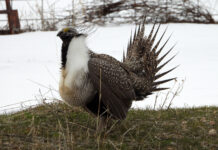The Great Salt Lake Collaborative is a group of news, education and media organizations – including The Globe, Amplify Utah and student journalists at Salt Lake Community College – that have come together to better inform and engage the public about the crisis facing the Great Salt Lake.

The Great Salt Lake Collaborative surveyed audience questions about the lake, and The Globe is publishing experts’ answers to your questions weekly. This week’s edition explores what locals can do to help the lake.
How can I help save the lake? (Whether that’s conservation solutions or donating to causes that can help)
A different perspective on water use and conservation from locals is needed to save the lake. Katie Newburn, the education and outreach director at Friends of Great Salt Lake, said Utahns use twice as much water in their yards than they use in their homes.
“Outdoor water use represents this really large portion of our total water consumption in Northern Utah and a big opportunity to conserve water, allowing more to reach Great Salt Lake,” Newburn said.
Utah is second in the nation for water use per person, more than twice the national average, according to data presented to the Great Salt Lake Collaborative by Sarah Null, associate professor of watershed sciences at Utah State University.
Newburn suggested these ideas to conserve water:
- Reduce outdoor watering. Fix broken sprinklers, limit how often the sprinklers run and shorten the duration of sprinkler runs. Use this weekly lawn watering guide to know when to water.
- Replace grass with drought-tolerant native plants.
- Urge your neighbors, HOAs and cities to conserve.
To support research about the lake, Newburn suggested donating to the Great Salt Lake Institute at Westminster College. (The institute is a member of the Great Salt Lake Collaborative.)
She also encouraged people to consider the membership program at Friends of Great Salt Lake.
“That’s a great way to support our efforts in the categories of education, research, advocacy and the arts,” Newburn said. “Join our community of members who are all invested in our mission.”
Other advocacy groups working on the lake include Utah Rivers Council, Great Salt Lake Audubon and The Nature Conservancy.
How much change is required to stabilize the lake?
The Great Salt Lake needs 5.4 to 12.8 million acre feet of water — about one to two Bear Lakes — to be healthy again, according to Null.
In order to accomplish this, significant change is required from people of the Wasatch Front.
Jaimi Butler, coordinator of the Great Salt Lake Institute at Westminster College, hopes to see these changes soon.
“About 85% of Utah lives right by Great Salt Lake. We all need to conserve water. Everybody needs to do everything they can,” Butler said.
For farmers, this may mean leasing water rights to the Great Salt Lake. Others can decrease the amount of water they use in their yards and lobby their neighbors to do the same. Cities can integrate water conservation when planning developments.
“Maybe you’re a sixth grader. You can conserve water and talk about the Great Salt Lake with your family,” Butler said. “The power is in your hands.”
Would helping the Great Salt Lake also help Utah Lake?
These two bodies of water are connected, so helping the Great Salt Lake will also help Utah Lake, and vice versa.
Dr. Ben Abbott, assistant professor at Brigham Young University, said these ecosystems are connected in three ways:
- They’re connected hydrologically, meaning that they’re a part of the same watershed. The Jordan River brings water from Utah Lake to the Great Salt Lake.
- They’re connected through biodiversity. Both lakes are a part of the Pacific Flyway that supports the ten million migrating birds each year. “Any of the habitat that we lose in one of these lakes, and around one of these lakes, puts more pressure on the habitat in the other,” Abbott said. “Any of the habitat that we can conserve or restore is helpful to those populations of wildlife.”
- They’re connected through the human and societal aspects. “There also are cultural, recreation and economic importance of these water bodies … I’m really encouraged as we look to the future, as we start to take a more watershed-wide approach,” Abbott said. “For us to solve issues in the Great Salt Lake, in Utah Lake, we need to be thinking about the entire watershed.”
What are some ways we can showcase the beauty and necessity of the lake?
Carla Trentelman, a sociologist who has conducted research on the lake, said photography can showcase the lake’s beauty and strengthen the bond communities feel with the lake.
“It might be kind of cool for the communities, or counties, that are near the lake to hold local photography exhibits or even competitions,” said Trentelman, whose research showed that people who had the most experience with the lake also wanted to protect it.
She also suggested people research their community’s connections to the lake. They may find ties to bird watching, hunting, farming, swimming or sunset-watching, for example.
“A lot of the communities know about those connections, but the folks living in those communities may not be aware of them,” Trentelman said.
Making new connections for youth is vital too, she said. Getting children to play in the sand and pretend they are scientists and explorers will lead to their wanting to preserve the lake.
“All those things help kids really develop a sense that this is a cool, magical place,” Trentelman told the Great Salt Lake Collaborative. “We need to get all our kids out there, and all our grandkids out there, and all our neighbors’ kids.”
Do you have a question about the lake? Visit the Great Salt Lake Collaborative website to participate in an audience survey.






